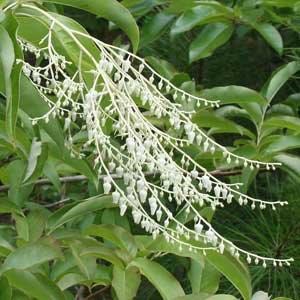Sourwood: a Honey of a Tree
go.ncsu.edu/readext?873651
en Español / em Português
El inglés es el idioma de control de esta página. En la medida en que haya algún conflicto entre la traducción al inglés y la traducción, el inglés prevalece.
Al hacer clic en el enlace de traducción se activa un servicio de traducción gratuito para convertir la página al español. Al igual que con cualquier traducción por Internet, la conversión no es sensible al contexto y puede que no traduzca el texto en su significado original. NC State Extension no garantiza la exactitud del texto traducido. Por favor, tenga en cuenta que algunas aplicaciones y/o servicios pueden no funcionar como se espera cuando se traducen.
Português
Inglês é o idioma de controle desta página. Na medida que haja algum conflito entre o texto original em Inglês e a tradução, o Inglês prevalece.
Ao clicar no link de tradução, um serviço gratuito de tradução será ativado para converter a página para o Português. Como em qualquer tradução pela internet, a conversão não é sensivel ao contexto e pode não ocorrer a tradução para o significado orginal. O serviço de Extensão da Carolina do Norte (NC State Extension) não garante a exatidão do texto traduzido. Por favor, observe que algumas funções ou serviços podem não funcionar como esperado após a tradução.
English
English is the controlling language of this page. To the extent there is any conflict between the English text and the translation, English controls.
Clicking on the translation link activates a free translation service to convert the page to Spanish. As with any Internet translation, the conversion is not context-sensitive and may not translate the text to its original meaning. NC State Extension does not guarantee the accuracy of the translated text. Please note that some applications and/or services may not function as expected when translated.
Collapse ▲Sourwood is one of our native ornamental trees that can add interest and value to the landscape. It is also called Lily-of-the-Valley tree because its panicles of flowers resemble those of the lily-of-the-valley plant. It blooms each year from June to August, attracting bees and butterflies. Sourwood (Oxydendrum arboreum) grows in regions throughout North Carolina, most notably through the Piedmont and westward to our mountains. It can often be found growing beside highways and on the edges of hardwood forests.
A deciduous tree, sourwood can be grown in full sun to part shade in acidic, well-drained soil. It is slow growing and can reach 20 to 30 feet. It prefers understory locations with the protection of tall trees and shrubs. The blooms are white, bell-shaped flowers located at the branch tips. With age, the bark becomes dense and furrowed. Leaves are finely-toothed and are said to be sour to the taste. Plant parts have been used by Native Americans, including the Catawba and the Cherokee, for medicinal purposes. They were also used in folk remedies for digestive issues. Sourwood is highly prized for the nectar of its flowers that is made into honey.
furrowed. Leaves are finely-toothed and are said to be sour to the taste. Plant parts have been used by Native Americans, including the Catawba and the Cherokee, for medicinal purposes. They were also used in folk remedies for digestive issues. Sourwood is highly prized for the nectar of its flowers that is made into honey.
Honey connoisseurs claim that an excellent crop of sourwood comes along about once in a decade depending on weather, timing and beekeeping skills. It is usually amber in color, sometimes with a gray tint. Its flavor has been described as ‘buttery sweet with rounded caramel notes on the back end with a slight aftertaste akin to gingerbread’. Count me in. Conservationist Carson Brewer who wrote about life in Appalachia mused that “most honey is made by bees, but sourwood is made by bees and angels”.
In the landscape, the growth habit of sourwood is not typically symmetrical or straight, perhaps adding a little character. In dense shade, the trunks are usually slender with a small canopy. In more open areas, the trunks are often leaning and usually divide into several stout limbs. Because of their shallow root system they can be difficult, if not impossible, to grow if transplanted from the wild. They can be hard to locate, but can be found in some nurseries and are worth the effort to find. As development continues and natural habitats decline, residential landscapes become more important in the support of healthy ecosystems. The use of native plants adds diversity, attracts wildlife and contributes to the design. Their connection to a region’s natural history is often lost when limited selections of exotic species that can be grown anywhere dominates the landscape. For more information, explore the extension plant toolbox at plants.ces.ncsu.edu/plants/oxydendrum-arboreum/
The sourwood is a great native tree to have in the understory layer of the landscape or where a smaller specimen is needed. They can be used in pollinator gardens, in native settings and in woodland areas. They have late blooming flowers in the spring and summer and beautiful fall foliage that ranges from peach to scarlet to reddish-purple. And lucky for us, they are sometimes visited by bees and angels.
Gail Griffin is an Extension Master Gardener Volunteer with North Carolina Cooperative Extension in Lee County.




